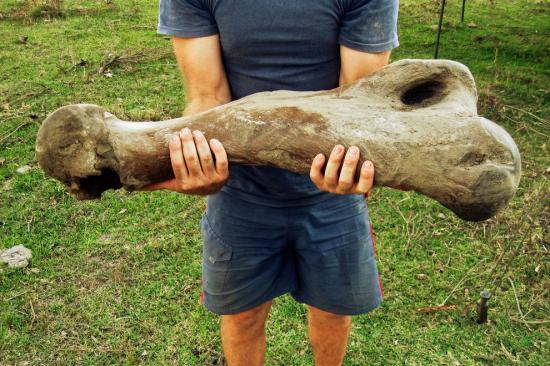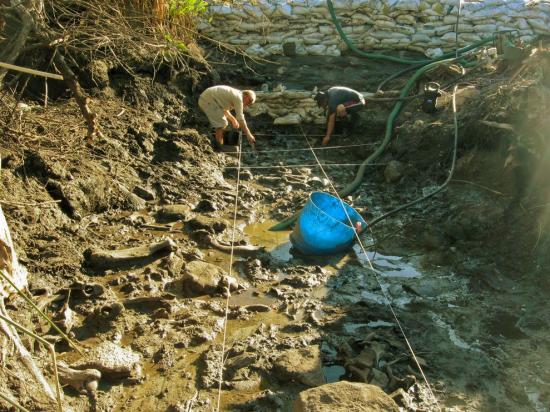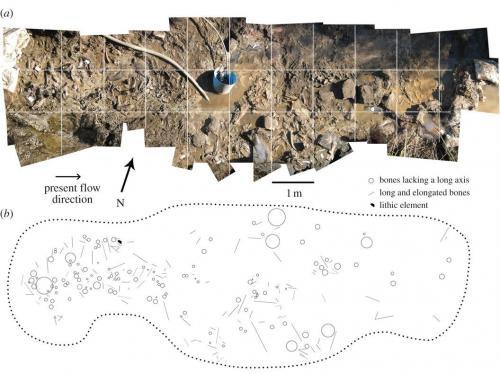Ancient giant sloth bones suggest humans were in Americas far earlier than thought
Bob Yirka report
Source - http://phys.org/news/2013-11-ancient-giant-sloth-bones-humans.html

A giant sloth bone might hold the key to the peopling of the Americas.PHOTOGRAPH BY MARTIN BATALLES

The giant sloth bones were uncovered at a dig site dated at 29,000 to 30,000 years old. PHOTOGRAPH BY MARTIN BATALLES

Panoramic view and orientation of the bones: (a) the bonebed showing the 1 m grid used to reference collected elements: (b) schematic of the bones to show their orientation. Credit: Proceedings of the Royal Society B: Biological Sciences, doi: 10.1098/rspb.2013.2211
A team of Uruguayan researchers working at the Arroyo del Vizcaíno site near Sauce, in Uruguay has found evidence in ancient sloth bones that suggests humans were in the area as far back as 30,000 years ago. The team describes their evidence and findings in a paper they've had published in Proceedings of the Royal Society B: Biological Sciences.
Most scientists today believe that humans populated the Americas approximately 16,000 years ago, and did so by walking across the Bering Strait, which would have been frozen over during that time period. More recent evidence has begun to suggest that humans were living in South America far earlier than that—just last month a team of excavators in Brazil discovered cave paintings and ceramics that have been dated to 30,000 years ago and now, in this new effort, the research team has found more evidence of people living in Uruguay around the same time.
In this new effort, the researchers found over a thousand bones at the Arroyo del Vizcaíno site, (from approximately 27 different animals) most of which once belonged to the now extinct giant sloth. What was most remarkable however, were the deep slash markings on some of the bones—indicative of human stone tools. Also interesting was that the bones were all from the remains of large, full grown sloths—all in a single place where they wouldn't have died in other ways such as from falling off a cliff. Taken together, it appears the sloths were killed individually, as needed, and eaten, most likely, by humans as no other known animal could have pulled off such a feat. The team also found a stone that appears to have been fashioned to serve as a scraping tool.
The researchers suggest that if humans were indeed in living in South America as far back as 30,000 years ago, they likely arrived there by floating over from Africa—the prevailing winds would have carried them directly there without the need of paddles or sails. Sloths, they suggest would have been an excellent food source once they arrived—adults would have been up to 15 feet tall and weighed approximately two to four tons, offering enough food for a group of people.
More information: Arroyo del Vizcaíno, Uruguay: a fossil-rich 30-ka-old megafaunal locality with cut-marked bones, Proceedings of the Royal Society B: Biological Sciences, Published 20 November 2013, DOI: 10.1098/rspb.2013.2211
Abstract
Human–megafauna interaction in the Americas has great scientific and ethical interest because of its implications on Pleistocene extinction. The Arroyo del Vizcaíno site near Sauce, Uruguay has already yielded over 1000 bones belonging to at least 27 individuals, mostly of the giant sloth Lestodon. The assemblage shows some taphonomic features suggestive of human presence, such as a mortality profile dominated by prime adults and little evidence of major fluvial transport. In addition, several bones present deep, asymmetrical, microstriated, sharp and shouldered marks similar to those produced by human stone tools. A few possible lithic elements have also been collected, one of which has the shape of a scraper and micropolish consistent with usage on dry hide. However, the radiocarbon age of the site is unexpectedly old (between 27 and 30 thousand years ago), and thus may be important for understanding the timing of the peopling of America.